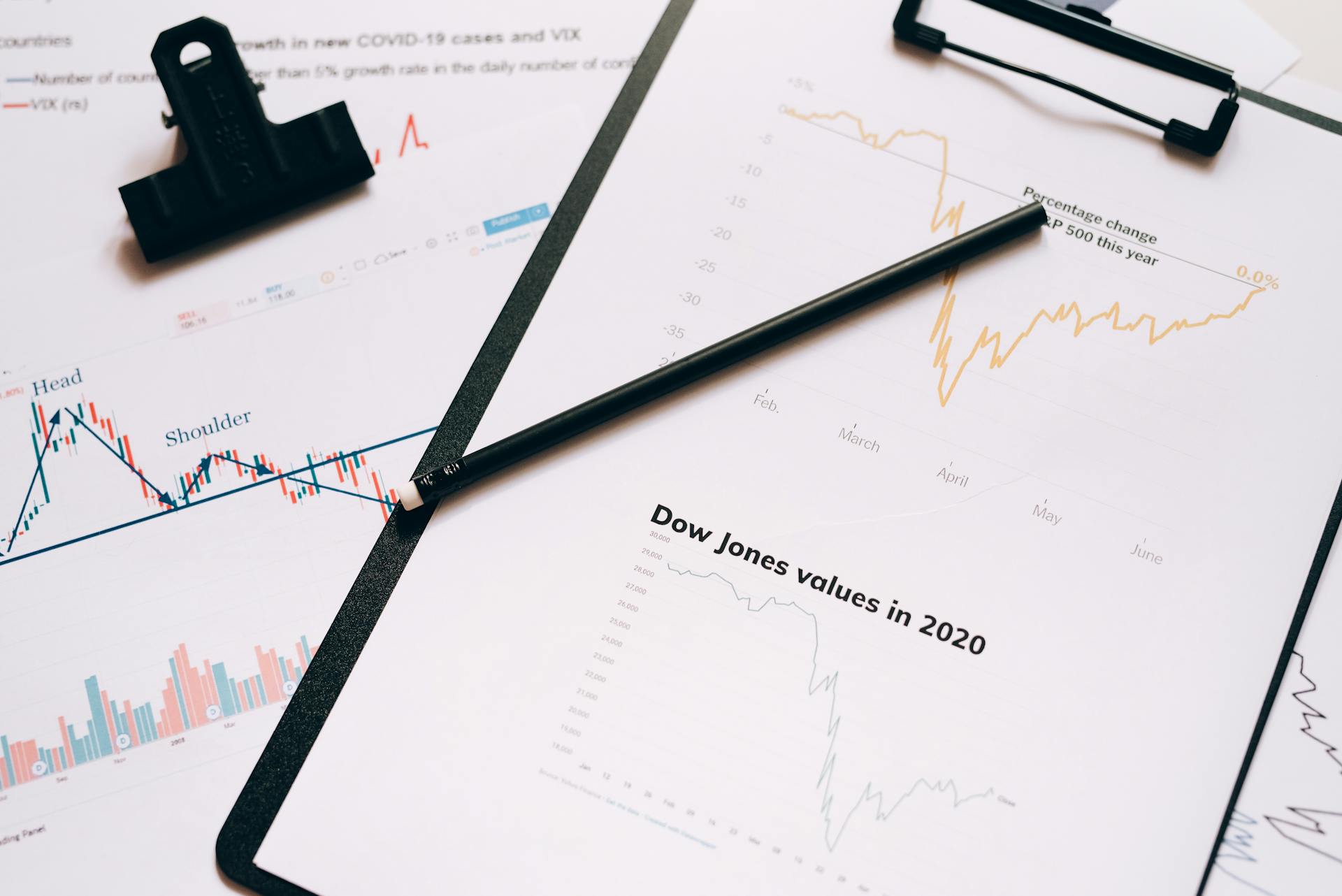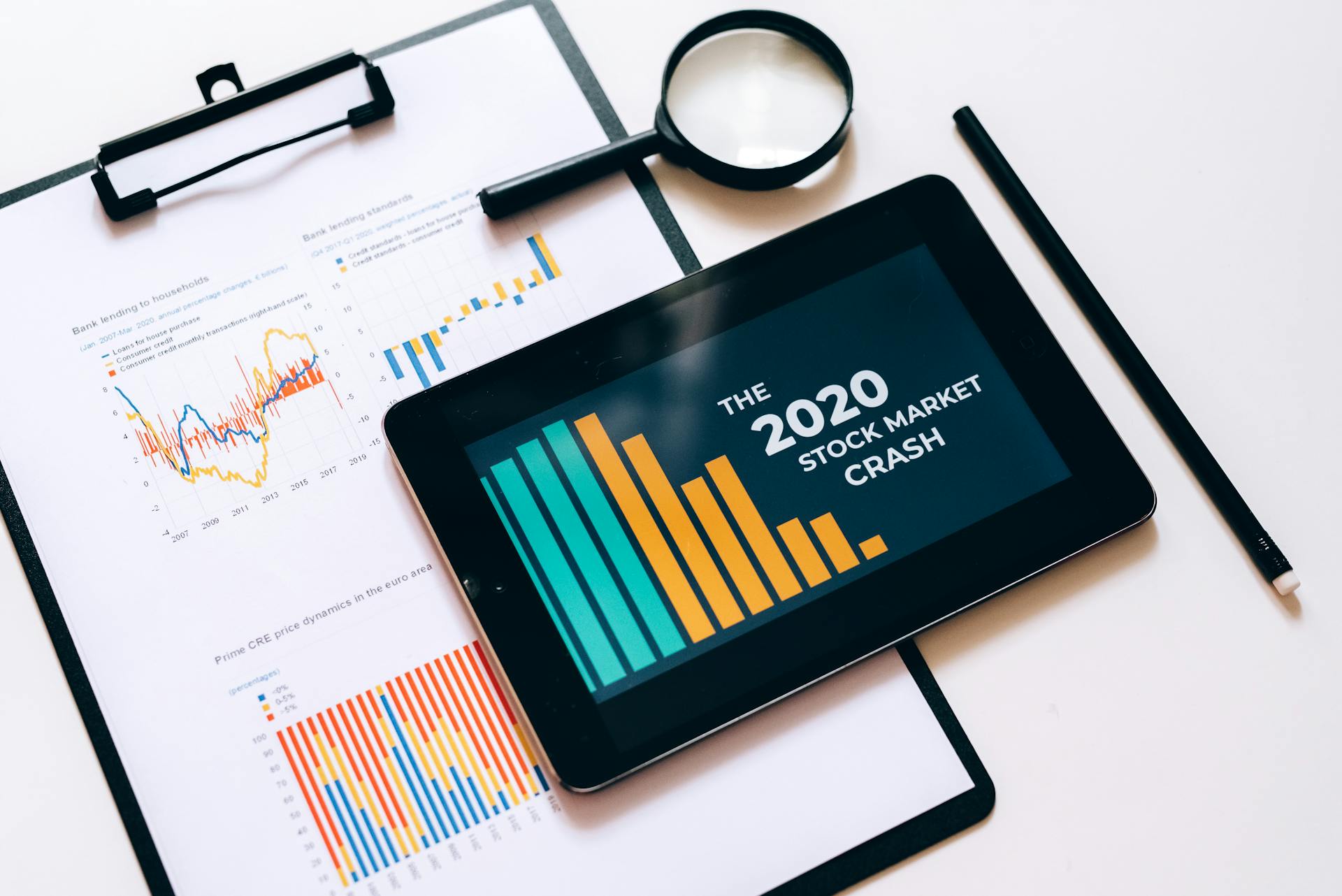
Investing in the stock market can be a great way to grow your wealth over time, but it's essential to have realistic expectations about the returns you can expect.
Historically, the stock market has returned around 7% per year over the long term, but this can vary significantly from year to year.
This means that if you invest $10,000 in the stock market, you can expect to earn around $700 in interest over a year, but this amount can fluctuate greatly.
Investors who are new to the stock market often expect to see returns of 10% or more per year, but this is not always realistic.
Calculating Investment Returns
Calculating investment returns can be a bit tricky, but it's essential to understand how your money is growing over time. The key is to look at long-term annualized returns, which provide a more reasonable expectation about future performance than short-term returns.
Short-term returns are volatile and unpredictable, so it's best to focus on the bigger picture. Research shows that a few low-fee index funds can be a good starting point for investors with limited time to devote to financial management.
Take a look at this: Time in the Market vs Timing the Market Graph

To calculate the return on your investment, you can use the ROI formula: subtract the initial amount from the final value, divide by the cost, and multiply by 100. However, keep in mind that ROI doesn't account for how long you'll hold onto the asset, so be sure to consider your time horizon when making investment decisions.
Remember, building wealth over time requires patience and a long-term perspective. By understanding how to calculate investment returns and choosing the right investments for your goals and risk tolerance, you can make informed decisions and achieve your financial objectives.
Investment Calculator
An investment calculator can be a valuable tool in determining how to meet your investment goals. It can help you understand how your initial investment, frequency of contributions, and risk tolerance can impact the growth of your money.
To get started with using an investment calculator, you'll need to provide some basic information. This typically includes your initial investment amount, the frequency of your contributions, and your desired return on investment.

A financial advisor can also help you manage your investment portfolio and make informed decisions about your investments. To find a financial advisor in your area, try using a free online matching tool like SmartAsset's.
An investment calculator can help you visualize the impact of different investment strategies on your portfolio. By inputting various scenarios, you can see how different combinations of initial investment, frequency of contributions, and risk tolerance can affect the growth of your money.
Here are some common types of investments that you may consider using an investment calculator for:
- Stocks: Individual stocks that can increase in value as a company grows.
- Index funds: A portfolio of stocks or bonds that tracks a market index.
- Exchange-traded funds (ETFs): A diversified investment that tracks the returns of a market index and can also be traded.
- Mutual funds: A collection of stocks, bonds, and other securities that are bundled and traded as one investment.
The Bottom Line
Long-term annualized returns are a more reliable indicator of future performance than short-term returns.
Short-term returns are notoriously volatile and unpredictable, making it challenging to gauge their reliability.
To make informed investment decisions, consider the purpose and time frame of your investment, as these factors significantly impact your risk tolerance and potential returns.
Inflation is a silent killer of wealth, eroding purchasing power over time.
Recommended read: Bill Ackman Short
Understanding Investment Risks
Investing in your 50s or 60s means you're closer to retirement, making dips in your portfolio more vulnerable. The closer you are to retirement, the more vulnerable you are to dips in your investment portfolio.
There's a trade-off between risk and return in investing. Investments with higher potential for return also have higher potential for risk. The safe-and-sound investments sometimes barely beat inflation, if they do at all.
Discover more: Retirement Etf Portfolio
Risk and
Risk and return are closely tied in investing. The investments with higher potential for return also have higher potential for risk.
As you get closer to retirement, you're more vulnerable to dips in your investment portfolio. Conventional wisdom suggests reducing exposure to risk by shifting some of your investments from stocks to bonds.
In general, there's a trade-off between risk and return. The safe-and-sound investments sometimes barely beat inflation, if they do at all.
Your age and risk tolerance will determine the asset allocation balance that's right for you. Finding this balance is crucial to managing your investment portfolio effectively.
Older investors who are getting closer to retirement should reduce their exposure to risk. This means shifting some of their investments from stocks to bonds.
The Rarity of Average

The concept of an "average" return on investment is often misunderstood, as it can be skewed by outliers.
Investors often rely on the S&P 500 average return of 10% to gauge their expectations, but this figure is not a reliable indicator of stock market returns for a specific year.
Outliers can greatly impact the annual average, making it seem more or less than it actually is.
For example, the average stock market return for the last 20 years was 9.75%, while the return for the last 10 years was 12.39%.
In 2003, the average return was a whopping 26.38%, while in 2009, it was 23.45%.
On the other hand, there were negative outliers that affected the 20-year average.
Here's a breakdown of the S&P 500 average return for the last 20 years, highlighting the impact of outliers:
This illustrates how outliers can greatly impact the annual average, making it essential to consider the entire picture rather than relying solely on the average return.
Investment Performance
The average stock market return is around 10%, but when adjusted for inflation, it's closer to 6%. This is because the value of money decreases over time due to inflation.
Historical returns can provide a reasonable expectation of an investment's growth over time. For example, in 2023, mutual funds in seven broad categories averaged an annual return of 13.1%. U.S. large-cap stock funds were the best-performing category.
The S&P 500 index represents the 500 largest publicly traded companies and is considered a good indicator of the overall market performance. It's rare that the average stock market return is precisely 10% in any given year.
Looking at the 15-year annualized return can be a more reliable gauge of future performance. For example, the 15-year annualized return of the S&P 500 Index as of June 7, 2024, was about 12.4%.
Here are the average mutual fund returns for seven major categories:
Keep in mind that past performance is no guarantee of future results, but looking at historical returns can give you a better understanding of what to expect.
Investment Options
Investment options can be overwhelming, but let's break it down. There are several types of investments to consider, each with its own level of risk and potential return.
One popular option is index funds, which track a market index and tend to have lower expenses and fees compared to actively managed funds. They're a great choice for those who want a long-term strategy that relies on the market to outperform single investments.
Another option is exchange-traded funds (ETFs), which combine features from stocks and index funds into a diversified investment. They're often traded on an exchange and can be bought and sold throughout the day.
Here are some of the most common investment options:
Mutual funds are often used for retirement and other long-term investments, and can provide a more diversified portfolio than individual stocks or ETFs.
Fund
Investing in mutual funds can be a great way to grow your money over time. Mutual funds pool money from many investors to buy a collection of stocks, bonds, and other securities. This can help spread out the risk and potentially increase returns.

The average mutual fund return for seven major categories is around 13.1% per year, with large-cap stock funds performing the best. U.S. large-cap stock funds, for instance, had an average return of 26.11% in 2023.
You can also look at the returns of specific mutual funds over different time periods. For example, the Vanguard 500 Index Investor had a 10-year return of 12.54% as of May 31, 2024.
Here's a breakdown of the average mutual fund returns for seven major categories:
Keep in mind that past performance is not a guarantee of future results, but it can give you a sense of what to expect.
ETF vs Fund
When choosing between an ETF and a mutual fund, consider how you want to trade and be taxed. ETFs can be bought and sold throughout the trading day, giving you greater control over taxation.
Both ETFs and mutual funds are pooled investment products where investors pool their funds to invest toward a shared goal. This shared goal can be anything from long-term growth to short-term gains.

ETFs and mutual funds that track similar indexes should have similar returns on average. This means you can expect similar results from both types of investments if you're investing in the same indexes.
Investing in either an ETF or a mutual fund involves risk, including the possible loss of principal. This is a risk you'll need to consider before making any investment decision.
Investment Planning
Investing is a long-term game, and it's essential to have a clear plan in place to achieve your financial goals. A financial advisor can help you manage your investment portfolio, so try SmartAsset's free online matching tool to find one who serves your area.
To get started, you'll need to consider your risk tolerance, which can affect the way your money grows. An investment calculator can help you figure out how your initial investment, frequency of contributions, and risk tolerance can all impact your returns.
You don't have to be a financial expert to become an investor, but it's crucial to understand the basics of investing. Investing lets you take money you're not spending and put it to work for you, earning compound interest over time.
Take a look at this: Ally Financial Dividend

To reach your long-term goals, consider investing in a mix of financial products, such as stocks, index funds, ETFs, and mutual funds. Here are some common financial investments to consider:
- Stocks: Individual stocks can increase in value as a company grows.
- Index funds: This asset tends to have lower expenses and fees compared to actively managed funds.
- Exchange-traded funds (ETFs): These combine features from stocks and index funds into a diversified investment.
- Mutual funds: This asset pools money from investors to buy a collection of stocks, bonds, and other securities.
Remember, investing is a marathon, not a sprint. It's essential to be patient and let your money grow over time, avoiding investing mistakes that can hinder your progress.
20 Years
Investing for 20 years can be a great way to grow your wealth over time. The power of compound interest can really add up, especially if you start investing early.
A financial advisor can help you manage your investment portfolio, but you can also use an investment calculator to figure out how your initial investment, frequency of contributions, and risk tolerance can affect your returns.
The average S&P 500 return over the last 20 years (2003 to 2023) is around 9.75%. This is a decent return, but it's essential to remember that past performance is not a guarantee of future results.
Here's an interesting read: Vanguard Index Funds S

To give you a better idea of what to expect, here's a breakdown of the average S&P 500 returns over different time periods:
Remember, investing for the long term can be a great way to ride out market fluctuations and potentially earn higher returns.
Sources
- https://smartasset.com/investing/investment-calculator
- https://www.sofi.com/learn/content/average-stock-market-return/
- https://corporate.vanguard.com/content/corporatesite/us/en/corp/vemo/vemo-return-forecasts.html
- https://www.thebalancemoney.com/what-is-the-average-mutual-fund-return-4773782
- https://www.linkedin.com/pulse/realistic-returns-logan-d-freeman
Featured Images: pexels.com


